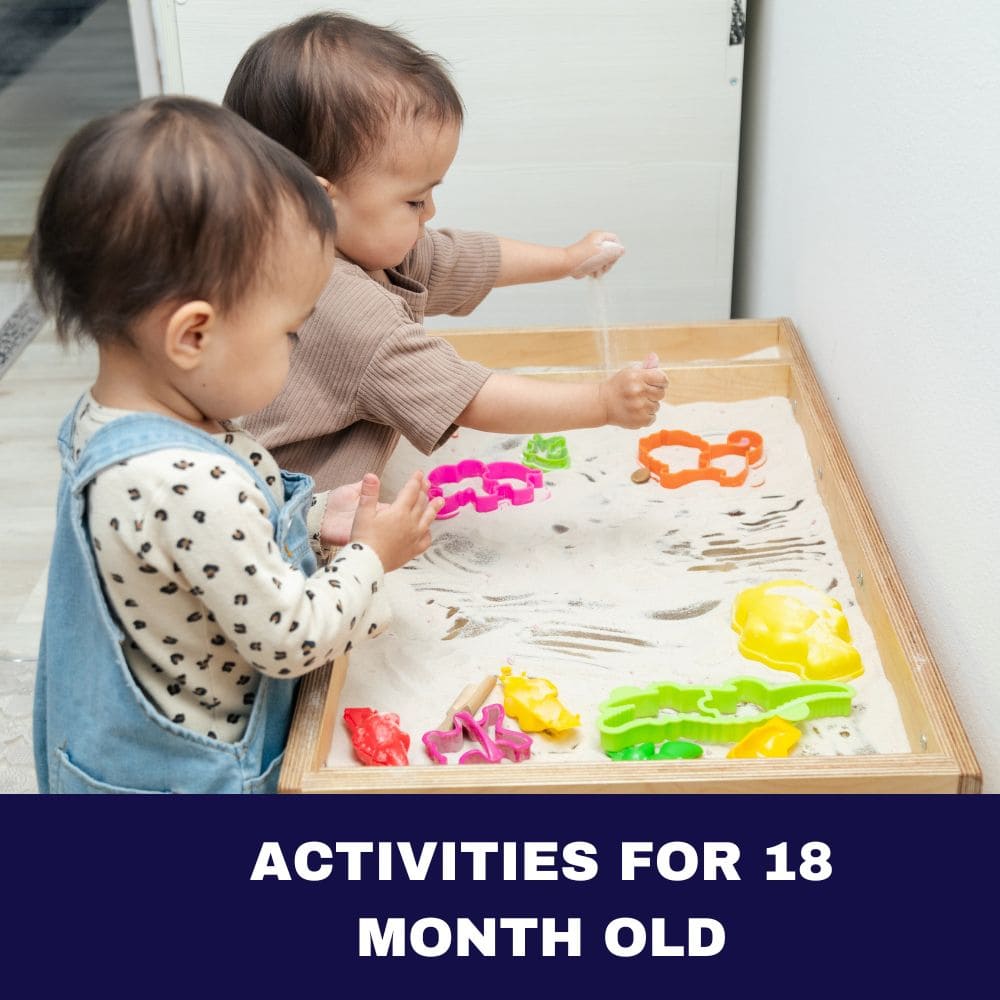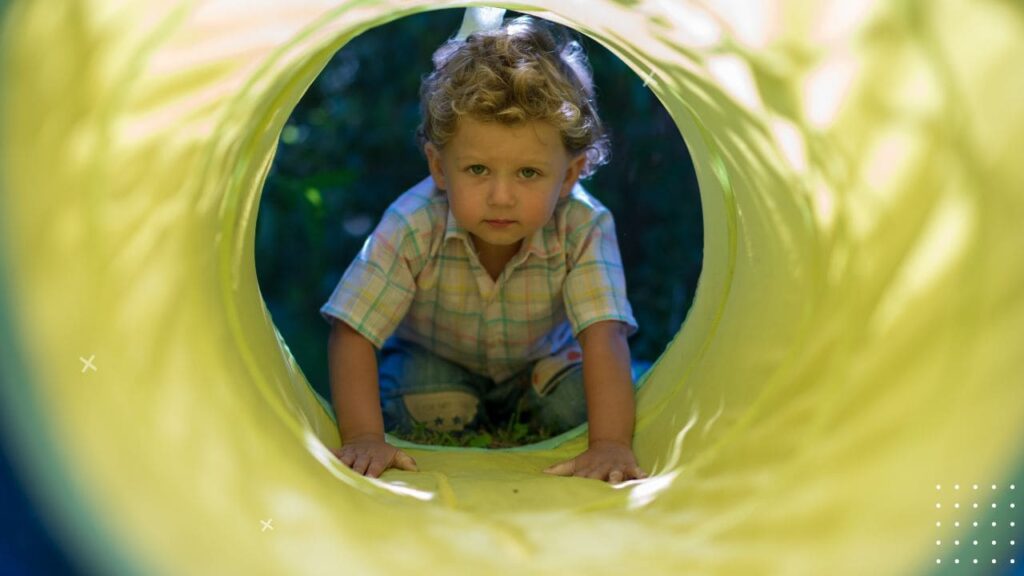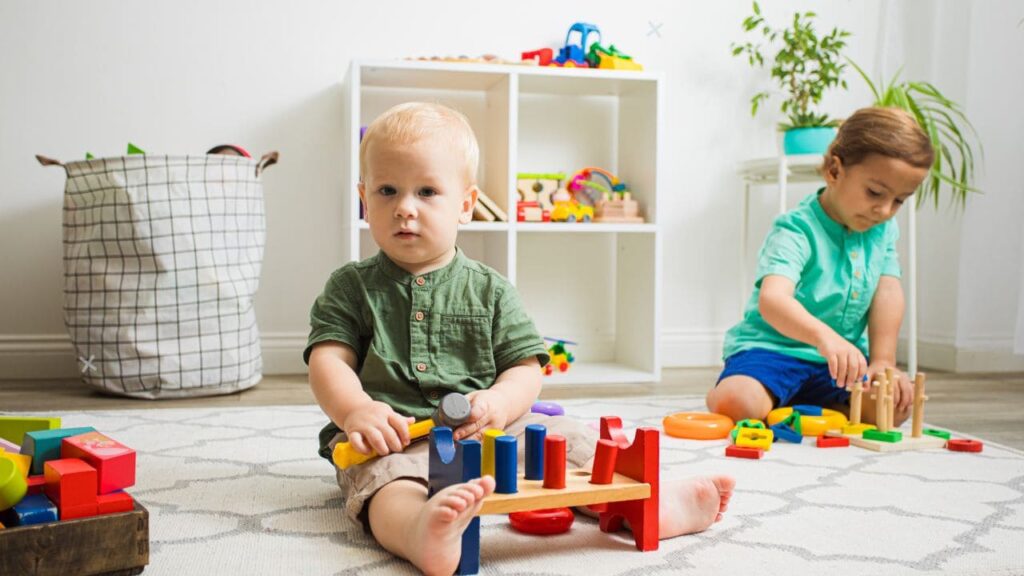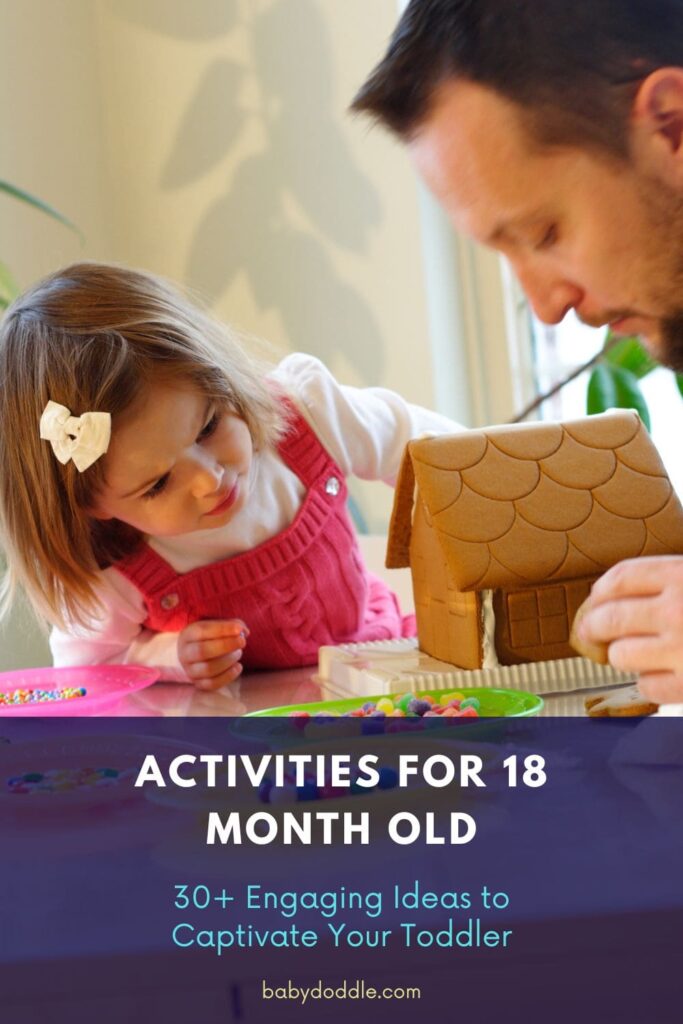
[ad_1]
Watching your little one grow and discover the world around them is one of the most rewarding experiences as a parent. At 18 months old, toddlers are like sponges, soaking up every new sight, sound, and sensation with wide-eyed curiosity. This incredible stage of development is a pivotal time for nurturing their cognitive, physical, and emotional growth through engaging activities for 18 month old.
As a parent, you might find yourself wondering, “What kinds of activities for 18 month old should I introduce to my 18-month-old?” or “How can I keep them entertained while fostering their development?” Well, you’ve come to the right place! In this blog post, we’ll explore over 30 captivating ideas to
Why Are Activities Important for 18 Month Olds?
At 18 months, your toddler is rapidly developing new skills and abilities daily. Engaging them in a variety of activities not only provides entertainment but also plays a crucial role in their overall growth and development. Here are some key reasons why activities are essential for 18-month-olds:
- Cognitive Development: Activities that involve problem-solving, exploration, and experimentation help strengthen your toddler’s cognitive abilities, such as reasoning, decision-making, and critical thinking.
- Language Development: Interactions, storytelling, and exposure to new words during activities foster language skills and expand your little one’s vocabulary.
- Motor Skills Development: Physical activities that involve gross and fine motor movements aid in the development of coordination, balance, and dexterity.
- Social and Emotional Development: Group activities and imaginative play promote social skills, emotional intelligence, and self-expression.
- Sensory Exploration: Engaging the senses through touch, sight, sound, smell, and taste helps your toddler better understand and interpret the world around them.
Developmental Benefits of Activities for 18 Month Olds
At 18 months, your toddler is going through a critical stage of development, and engaging them in various activities can have a profound impact on their growth. Here are some key developmental benefits of incorporating activities into your toddler’s routine:
Cognitive Development:
- Activities that involve problem-solving, sorting, matching, and cause-and-effect help build essential cognitive skills like reasoning, decision-making, and critical thinking.
- Exposure to new concepts, colors, shapes, and numbers through activities lays the foundation for early academic skills.
Language Development:
- Engaging in activities that involve singing, reading, and conversations exposes your toddler to new words, boosting their vocabulary and language comprehension.
- Activities that encourage back-and-forth interactions foster your toddler’s ability to communicate and express themselves.
Physical Development:
- Gross motor activities like crawling, climbing, and dancing promote strength, balance, and coordination, supporting your toddler’s growing physical abilities.
- Fine motor activities involving grasping, manipulating, and transferring objects help develop dexterity and hand-eye coordination.
Social and Emotional Development:
- Group activities and parallel play with peers foster social skills like sharing, taking turns, and understanding boundaries.
- Imaginative play and pretend scenarios allow your toddler to explore and express emotions in a safe environment.
By incorporating a variety of activities into your toddler’s routine, you’re providing them with opportunities to develop a well-rounded skill set, setting the stage for future learning and growth.
What Should an 18 Month Old Be Learning?
At this age, your toddler is rapidly developing a wide range of skills and abilities. Here are some key developmental milestones that 18-month-olds typically work on:
- Language and Communication: Expanding their vocabulary, understanding simple instructions, and using two-word phrases.
- Cognitive Skills: Recognizing familiar objects, matching shapes and colors, and problem-solving skills.
- Physical Development: Improved coordination, walking steadily, climbing, and throwing/kicking balls.
- Social and Emotional Skills: Expressing emotions, developing independence, and engaging in parallel play with peers.
By incorporating activities that target these areas, you’ll be supporting your toddler’s overall growth and development.
| Area of Development | Milestones |
|---|---|
| Cognitive Development | Understands simple instructions Can point to body parts Identifies familiar objects |
| Language Development | Vocabulary of around 10-20 words Uses two-word phrases Follows simple commands |
| Physical Development | Walks steadily Can climb on furniture Throws and kicks balls |
| Social and Emotional Development | Engages in parallel play Shows affection Expresses emotions like fear and joy |
Age-Appropriate Activities for 18 Month Old Babies
Now, let’s dive into the fun part – the activities! Here are over 30 engaging ideas to captivate your 18-month-old:
Cognitive and Language Development Activities
- Reading Books: Snuggling up and reading age-appropriate books is not only a bonding experience but also introduces new words, concepts, and storytelling.
- Singing Songs: Singing nursery rhymes and simple songs helps develop language skills, memory, and rhythm.
- Playing with Puzzles or Shape Sorters: These activities encourage problem-solving, shape recognition, and hand-eye coordination.
- Sticking Letters to Windows: Cut out letters from construction paper and let your toddler stick them to a window. This helps with letter recognition and fine motor skills.
- Fishing for Letters: Create a “fishing pond” with letters in a small pool or container, and let your toddler “catch” them with a magnetic fishing rod. A fun way to learn letters!
Next Step Advice: Engage your toddler in conversations during these activities, asking open-ended questions, and providing positive reinforcement for their efforts.
Fine Motor Skills Activities
- Finger Painting: Let your little one explore textures and colors by dipping their fingers in washable paint and creating masterpieces on paper.
- Playing with Playdough: Rolling, squishing, and shaping playdough is an excellent way to strengthen tiny hand muscles.
- Stringing Beads: Provide large beads and a string or pipe cleaner for your toddler to practice their grasping and threading skills.
- Sorting Colors in Muffin Tins: Fill muffin tins with different colored pom-poms, buttons, or small objects, and let your toddler sort them by color.
- Playing with Pom-Poms: Encourage your toddler to pick up, transfer, and drop pom-poms into containers to improve their pincer grasp.
Next Step Advice: Set up a dedicated space for fine motor activities, and rotate the materials regularly to keep your toddler engaged and challenged.

Gross Motor Skills Activities
- Crawling Tunnels: Set up tunnels made from cardboard boxes or blankets for your toddler to crawl through, fostering their coordination and strength.
- Ball Games: Rolling, throwing, and kicking balls of different sizes and textures helps develop gross motor skills and hand-eye coordination.
- Dancing to Music: Put on some lively tunes and encourage your toddler to move their body, boosting their balance and rhythm.
- Climbing on Playground Structures: Visit local playgrounds or set up climbing structures at home for your toddler to practice their climbing and balancing abilities.
- Pulling Toys Behind: Provide pull-along toys or wagons for your toddler to practice walking and pulling, improving their strength and coordination.
Next Step Advice: Ensure a safe environment for gross motor activities, clear of obstacles and hazards, and provide constant supervision.

Sensory Exploration Activities
- Water Play: Fill a shallow tub or container with water and provide cups, sponges, and toys for your toddler to splash and explore.
- Texture Boxes: Create boxes filled with different textures, such as sand, rice, or shredded paper, for your toddler to touch and manipulate.
- Scavenger Hunts: Set up a simple scavenger hunt around the house or yard, encouraging your toddler to use their senses to find hidden objects.
- Sensory Bottles: Make homemade sensory bottles by filling clear plastic bottles with water, glitter, beads, or other safe materials for your toddler to shake and observe.
- Fake Snow Play: Create a winter wonderland indoors by mixing baking soda and shaving cream for a safe, moldable “snow” experience.
Next Step Advice: Encourage your toddler to describe the textures, sounds, and sensations they experience during these activities to promote language development.
Pretend Play and Imaginative Activities
- Matching Animal Figures: Provide a variety of plastic animal figures and encourage your toddler to match them or create imaginative scenarios.
- Dress-Up Activities: Let your toddler explore different roles and emotions by providing dress-up clothes, accessories, and props.
- Pretend Cooking: Set up a play kitchen area with pots, pans, and pretend food for your toddler to “cook” and practice role-playing.
- Building Forts: Use blankets, pillows, and couch cushions to construct indoor forts or dens for imaginative play and adventure.
- Puppet Shows: Create simple puppets out of socks or paper bags and put on shows, encouraging your toddler to participate and express themselves.
Next Step Advice: Join in the pretend play and follow your toddler’s lead, asking open-ended questions and providing positive reinforcement for their creativity.
Simple and Easy-to-Set-Up Activities
- Sorting by Shapes: Gather various household items (e.g., blocks, cups, lids) and encourage your toddler to sort them by shape.
- Stacking: Provide cups, boxes, or rings of different sizes for your toddler to practice their stacking and balancing skills.
- Playing Colorama: Create a simple color matching game by placing colored objects or cards on the floor and asking your toddler to find matching colors.
Next Step Advice: Rotate the materials regularly to keep these activities fresh and engaging for your 18-month-old.

Outdoor Activities for 18 Month Olds
- Nature Walks: Take your toddler on short walks around the neighborhood or local parks, pointing out different sights, sounds, and textures in nature.
- Playground Visits: Visit local playgrounds and encourage your toddler to explore the different equipment, slides, and swings.
- Gardening: Involve your toddler in simple gardening tasks, such as watering plants, digging in the soil, or planting seeds.
- Sidewalk Chalk Art: Provide sidewalk chalk and let your toddler’s creativity flow by drawing, scribbling, and making colorful masterpieces on the pavement.
Next Step Advice: Pack a small bag with snacks, water, and essentials for outdoor activities to keep your toddler comfortable and hydrated.
Social Activities for 18 Month Olds
- Hanging Out with Other Toddlers: Arrange playdates or attend toddler groups to encourage social interaction and parallel play with peers.
- Family Game Time: Introduce simple group games, such as rolling a ball back and forth or singing action songs together.
- Storytime at the Library: Attend storytimes at your local library or bookstore, exposing your toddler to new stories and social settings.
Next Step Advice: Model positive social behaviors, such as sharing, taking turns, and using gentle tones, to help your toddler develop essential social skills.
Tips for Engaging Your 18 Month Old
Keeping an 18-month-old engaged can be challenging, but with these tips, you’ll be able to make the most of your activities:
- Follow Their Lead: Observe your toddler’s interests and inclinations, and tailor activities accordingly. This will foster their natural curiosity and enthusiasm.
- Use Positive Reinforcement: Praise and encourage your toddler’s efforts, no matter how small. This will boost their confidence and motivation to explore further.
- Keep it Short and Sweet: Toddlers have short attention spans, so aim for bite-sized activities lasting 10-15 minutes before transitioning to something new.
- Rotate Activities: Introduce new activities regularly to prevent boredom and keep your toddler’s mind stimulated.
- Create a Dedicated Play Area: Designate a child-friendly space for activities, with age-appropriate materials within reach.
- Join the Fun: Participate in the activities with your toddler, modeling enthusiasm and engagement.
Next Step Advice: Observe your toddler’s cues and adjust the pace or activity as needed. Their interest and enjoyment should be the primary focus.
Adapting Activities for Different Learning Styles
Every child is unique, and their preferred learning style may differ. Some toddlers thrive with visual cues, while others respond better to hands-on or auditory experiences. To ensure your 18-month-old remains engaged and motivated, it’s essential to adapt activities to their individual learning style. Here are some tips:
Visual Learners:
- Incorporate colorful materials, picture books, and visual aids into activities.
- Use hand gestures and facial expressions to emphasize concepts.
- Encourage your toddler to observe and imitate your actions.
Kinesthetic Learners:
- Provide hands-on activities that involve movement and tactile exploration.
- Incorporate music and dance into learning experiences.
- Encourage your toddler to manipulate objects and engage in sensory play.
Auditory Learners:
- Use rhythmic patterns, songs, and rhymes to introduce new concepts.
- Read aloud with enthusiasm and varied intonation.
- Engage in conversations and encourage your toddler to respond verbally.
By adapting activities to your toddler’s learning style, you’ll not only keep them engaged but also cater to their natural strengths and preferences, fostering a love for learning from an early age.
Incorporating Learning Themes
To keep your 18-month-old’s activities fresh and engaging, consider incorporating learning themes. Themes not only provide structure and focus but also allow you to explore a wide range of concepts and skills within a familiar context. Here are some theme ideas to get you started:
Nature and Animals:
- Read books about different animals and their habitats.
- Create sensory bins with natural materials like pinecones, leaves, and shells.
- Go on nature walks and observe the sights, sounds, and textures around you.
Transportation:
- Introduce toy vehicles and encourage your toddler to move and sort them.
- Create roads and ramps using masking tape or cardboard for cars to travel on.
- Read books and sing songs about different modes of transportation.
Food and Cooking:
- Set up a play kitchen area and encourage pretend cooking and serving.
- Explore different food textures, colors, and smells through sensory activities.
- Read books about healthy foods and involve your toddler in simple cooking tasks.
By rotating themes regularly, you’ll not only keep your toddler engaged but also expose them to a diverse range of concepts and experiences, fostering their overall development.
Encouraging Independence and Self-Help Skills
As your toddler approaches their second year, it’s essential to nurture their growing sense of independence and self-help skills. Engaging them in activities that promote these abilities will not only boost their confidence but also lay the foundation for future self-sufficiency. Here are some ideas:
Self-Feeding:
- Provide child-friendly utensils and encourage your toddler to feed themselves during mealtimes.
- Set up a snack station with healthy options they can access independently.
- Involve your toddler in simple food preparation tasks, like mixing or spreading.
Dressing and Grooming:
- Encourage your toddler to practice taking off and putting on simple clothing items.
- Set up a mirror and let them explore brushing their hair or teeth (with supervision).
- Use songs or rhymes to make dressing and grooming routines more enjoyable.
Cleaning Up:
- Introduce a designated bin or basket for your toddler to help clean up toys and materials.
- Model and encourage them to put away items after use.
- Turn clean-up into a game or sing a clean-up song to make it more engaging.
By fostering independence and self-help skills through activities, you’re not only promoting your toddler’s sense of accomplishment but also laying the groundwork for future self-care and responsibility.
Safety Considerations for 18 Month Old Activities
While engaging in activities, it’s crucial to prioritize your toddler’s safety. Here are some important considerations:
- Supervision: Never leave your 18-month-old unattended during activities, as they can quickly get into precarious situations.
- Age-Appropriate Materials: Choose toys and materials specifically designed for toddlers, free from small parts or potential choking hazards.
- Childproofing: Ensure your home is childproofed by securing furniture, covering electrical outlets, and removing any potential hazards.
- Outdoor Safety: When playing outside, keep your toddler within a safe, enclosed area and apply sunscreen and protective gear as needed.
- Hygiene: Encourage frequent handwashing, especially before meals and after messy activities, to prevent the spread of germs.
Next Step Advice: Regularly inspect toys and activity materials for wear and tear, and discard any damaged or potentially unsafe items.
Conclusion
As you can see, there’s an abundance of engaging activities to captivate your 18-month-old’s curiosity and support their overall development. Whether you’re fostering cognitive skills, motor abilities, language acquisition, or social-emotional growth, these 30+ ideas offer a diverse range of options.
Remember, every child is unique, and their interests and preferences may vary. Observe your toddler’s cues, follow their lead, and adapt these activities to suit their individual needs and learning styles. Most importantly, have fun and enjoy this precious time of growth and discovery together.
Embrace the messy moments, the giggles, and the endless curiosity that comes with this amazing age. By providing a nurturing and stimulating environment filled with engaging activities, you’re laying a strong foundation for your little one’s future success and happiness.
So, get creative, get hands-on, and embark on this exciting journey of exploration and learning with your 18-month-old. The world is their playground, and you’re their ultimate guide!
FAQ – Activities for 18 Month Old
How long should activity sessions be for an 18-month-old?
At this age, toddlers have relatively short attention spans, so it’s best to keep activity sessions brief, typically 10-15 minutes per activity. However, every child is different, so watch for cues that your little one is losing interest or becoming overstimulated. It’s perfectly fine to break up activities into shorter bursts or transition to a new activity when needed.
The key is to follow your toddler’s lead and adjust the pace and duration accordingly. Remember, the goal is to keep them engaged and enjoying the experience, not forcing them to participate longer than their attention span allows.
Is it necessary to have a dedicated play area for activities?
While not absolutely essential, having a designated play area can be beneficial for several reasons. First, it provides a safe and contained space specifically designed for engaging activities, free from potential hazards or distractions. Second, it allows you to keep age-appropriate toys and materials readily available, encouraging independent play and exploration.
That being said, activities can certainly occur in various areas of your home or outdoor spaces. The important thing is to ensure the environment is childproofed and free from potential dangers. You can also create temporary play areas by setting up a blanket or clearing a space on the floor.
How can I incorporate learning into everyday activities?
Learning doesn’t have to be confined to structured activities or educational toys. In fact, many everyday tasks and routines can be transformed into valuable learning experiences for your 18-month-old. Here are some ideas:
- During mealtimes, talk about the colors, textures, and names of the foods you’re eating.
- While getting dressed, sing songs about body parts or practice identifying colors and patterns on clothing.
- In the bath, introduce concepts like floating and sinking, or practice pouring and transferring water between containers.
- When running errands, point out and name objects, shapes, and colors you encounter along the way.
The key is to narrate your actions, ask questions, and engage your toddler in the world around them. By doing so, you’re turning everyday moments into opportunities for learning and exploration.
How can I encourage my 18-month-old’s independence during activities?
Fostering a sense of independence and self-help skills is an essential part of your toddler’s development at this age. Here are some ways to encourage independence during activities:
- Offer choices: Let your toddler choose between two or three activity options, allowing them to exercise their autonomy.
- Encourage self-feeding: Provide age-appropriate utensils and let them practice feeding themselves during mealtimes or snack times.
- Involve them in clean-up: Give them a designated bin or basket to help put away toys and materials after an activity.
- Allow exploration: Create a safe, enclosed space where they can freely explore and manipulate objects without constant intervention.
- Use positive reinforcement: Praise and celebrate their efforts and accomplishments, no matter how small, to boost their confidence.
Remember, independence is a process, and it’s important to be patient and supportive as your toddler navigates this exciting developmental stage.
What if my 18-month-old seems uninterested in the activities I’ve planned?
It’s perfectly normal for toddlers to lose interest or become disengaged from activities, even ones they previously enjoyed. Here are some tips for handling these situations:
- Follow their lead: Observe your toddler’s cues and adjust the activity or transition to something new if they seem bored or frustrated.
- Mix it up: Rotate activities and introduce new materials regularly to maintain novelty and interest.
- Take a break: Sometimes, a brief break or a change of scenery is all that’s needed to re-engage their attention.
- Adapt to their learning style: Tweak activities to better align with your toddler’s preferred learning method (visual, auditory, kinesthetic).
- Make it a game: Add an element of fun or turn the activity into a game to reignite their enthusiasm.
Remember, the goal is to foster a love for learning and exploration, not force participation. By remaining flexible and responsive to your toddler’s needs and interests, you’ll create a more enjoyable and engaging experience for both of you.

[ad_2]